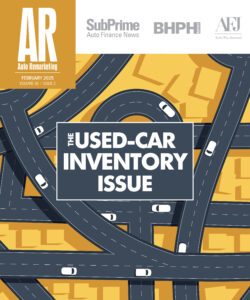Used inventory still a factor as AutoNation, Asbury share positive outlook

An analyst during the Q&A portion of AutoNation’s third-quarter earnings call on Thursday asked whether the retailer was comfortable with the current inventory levels for used vehicles. The company’s president and CEO Mike Manley answered yes.
“But as we all know in our business, your used inventory can be one of your biggest assets,” Manley said. “But it also can bite you.”
He went on to say AutoNation breaks its used inventory down into under-$20,000, $20,000 to $40,000 and $40,000-plus brackets.
The company is short on very-good-quality under-$20,000 vehicles.
“And notwithstanding the fact that they're a focus for us and We Buy Your Car teams, the reality is that you don't want to be buying too deep because you end up buying bad inventory that frankly, costs way too much to get prepared for the right quality to retail,” Manley said.
Asbury Automotive Group’s Q3 earnings call took place on the same day as AutoNation’s, and overall, Asbury reported record third quarter 2022 net income. Asbury senior vice president of operations Daniel Clara said used retail revenue was flat in relation to last year.
Asbury’s total used-vehicle inventory ended the quarter at $368 million. The company’s used-to-new ratio for the quarter was 120%, and that was an increase from 112% in the prior year quarter. It was in line with the company’s second quarter of 2022.
AutoNation: Used inventory being ‘appropriately managed’
AutoNation also reported record third quarter results, and Manley said that was partly a result of higher average selling prices of new and used vehicles, continued consistent growth in after-sales and the company’s customer financial services, which Manley said more than offset lower sales of new and used vehicles.
Manley reported that the expansion of company’s AutoNation USA standalone, used-car operation, continued with the opening of its 12th store, this one in Kennesaw, Ga.
“And although we are seeing some delays in our launch schedule as a result of [a] challenging construction market, we have a significant number of projects underway in our pipeline,” Manley said.
Before reporting in more detail about AutoNation’s used-vehicle performance in the quarter, Manley said new-vehicle demand remained strong in the period.
Although the company ended September with slightly higher inventory levels because of higher year-over-year shipments, new-vehicle inventory continues to be a constraint, and he said the company remained at historically low days of supply.
Manley reported that new-vehicle margin in the quarter was up $450 per unit year-over-year, but down sequentially driven mainly by mix rather than major pricing actions.
During the Q&A portion of the AutoNation call, John Murphy of Bank of America asked Manley to address “the elephant in the room,” which is the lack of inventory and how automakers “are having a tough time ramping up.” He asked Manley when inventory might return to normal levels, if ever.
Manley answered that the real question is whether a balance would occur that enables reasonable margins for dealers and OEMs.
“So, when we say return to normal, I frankly don’t think margins will return to pre-2020 levels, because I do believe that we are going to see discipline in the inventory levels,” Manley said.
But during his initial comments, Manley said used-vehicle margins were down year-over-year, which was to be expected because last year the company was “in the highly unusual situation” of “appreciating used-vehicle values.” He added that used wholesale dynamics through the quarter have mostly returned to what he described as “a more normalized pattern of depreciation.”
But he said used-vehicle margin continued to be higher than the low point of the first quarter.
“Used-vehicle inventory in the group is being appropriately managed, I think, with quarter-end day supply of just about 30 days,” he said.
He continued, “Mix, however, remains a key focus for us as we continue to see availability issues in the sub-$20,000 price band, where inventory levels year-over-year are approximately 25% lower, which, as a result, despite continued strong demand in this part of the segment, I think, is restricting overall used-vehicle volumes.”
Good news from the report was in regard to sourcing of used-vehicle inventory.
Manley described sourcing as a “considerable strength within the group,” as the company is self-sourcing more than 90% of used inventory from trading, We Buy Your Car activities, and additional controlled sources.
In other news, Manley said that as the company completed its acquisition of auto finance company CIG Financial on Oct. 1, it has already started the integration process and launched group financial services in its AutoNation USA stores.
Asbury: All-time record sales for Clicklane
Asbury during the earnings call did not spend much time addressing the used-vehicle portion of its business, but the numbers looked strong in that area. For the total company in the third quarter vs. the third quarter of 2021 for Asbury, used-vehicle retail unit volume increased 40%. Used- vehicle retail revenue increased 52%, and gross profit increased 22%.
For same store (dealership only) looking at third quarter 2022 vs. third quarter 2021, used- vehicle retail unit volume decreased 10%, and as mentioned earlier, used-vehicle retail revenue was flat. Used-vehicle retail gross profit decreased 30%.
Clara addressed the ongoing inventory situation, saying that new-vehicle inventory continues to remain well below normal. Consumer demand exceeded supply.
But the highlight of the earnings call for Asbury seemed to be Clicklane, its 100% digital retail sales platform. The company reported an all-time record of more than 6,800 vehicles sold through the platform, which was a 13% increase over the prior-year quarter. Forty-one percent of Clicklane sales had a trade-in. One hundred percent of those with payoffs used the payoff tool. Clicklane has now been rolled out to all Asbury dealerships.
Asbury president and CEO David Hult addressed how Hurricane Ian affected the company, saying that day supply increased to 19 days, which was partially due to deliveries delayed by the hurricane, but it was still a low day supply in inventory and affected overall unit sales.
He said team members living in the path of the storm are safe.
“Also, thanks to the preparedness of our teams, we are fortunate in avoiding any notable damage to our stores and inventories,” he said.

 View The Latest Edition
View The Latest Edition

